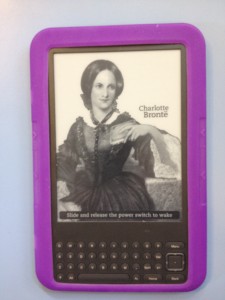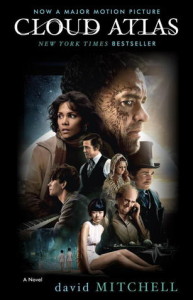Everything Science Knows About Reading On Screens
This article summarizes research into how we read differently on screens than in books. Of course not all screens are the same: A smartphone screen is much smaller than a laptop or desktop computer screen, a Kindle is different from an iPad. “But many researchers say that reading onscreen encourages a particular style of reading called “nonlinear” reading—basically, skimming.”
 Research by Ziming Liu, a professor at San Jose State University, has found that “sustained attention seems to decline when people read onscreen rather than on paper, and that people also spend less time on in-depth reading.” When we read on a computer, hyperlinks, ads, media (such as videos), and other text draws our attention away from the material we’re reading.
Research by Ziming Liu, a professor at San Jose State University, has found that “sustained attention seems to decline when people read onscreen rather than on paper, and that people also spend less time on in-depth reading.” When we read on a computer, hyperlinks, ads, media (such as videos), and other text draws our attention away from the material we’re reading.
Any discussion of the difference between electronic devices and books must take into consideration the kind of material being read:
Nonlinear reading might especially hurt what researchers call “deep-reading”—our in-depth reading of text that requires intense focus to fully understand it, like the works of James Joyce or Virginia Woolf.
I find reading nonfiction online much easier than reading fiction, particularly if the content I’m reading has been maximized for on-screen reading with headings dividing the sections.
One thing most researchers on this topic agree on is that “the screen-reading vs. traditional reading question has nuances that scientists have yet to fully understand.”
Ultimately, it may be that both print and screen have unique advantages, and we’ll need to be able to read equally well on both—which means keeping our distracted habits onscreen from bleeding into what we read on an e-book or paperback.
If you click on the link to this article, you’ll see that it contains two animated gifs comprising lines moving across the screen. Many commenters at the end of the article asked why these annoying distractions were included. Any content producer interested in actually exploring the question of how well we can read on screen surely would not have included these. For an article claiming to examine the science, this trick is disingenuous.
The 7 Types of People You See in EVERY Bookstore
If you choose to read printed books, Amy Sachs assures you that, when you go to the bookstore, you’ll find these seven types there as well:
- The Aisle-Sitter
- The People Who Make Themselves At Home
- The Kid Being Dragged by Parents
- The Kid Who Wants ALL THE BOOKS
- The Time Waster
- The Guy Who’s Only There For Coffee
- The Student
The article illustrates each of these categories with an animated gif. Unlike the annoying distractions in the article above, these at least pertain to the article’s content and are amusing to boot.
100 Must-Read Books on English: Essays, Writing, and Literary Criticism
According to the introduction, “Mixed in there are many superb books on journalism, film criticism, and literary theory.”
There’s a lot to choose from here, although some of them are more in the “must read” category than others.
HOW CHANGING YOUR READING HABITS CAN TRANSFORM YOUR HEALTH
Michael Grothaus writes that reading War and Peace during a downturn in his life “changed something in me. It’s almost impossible to explain why, but after reading it I felt more confident in myself, less uncertain about my future. I became more assertive with my bosses. I got back on the horse, so to speak.”
For an explanation of how this happened, he turns to Dr. Josie Billington, deputy director of the Centre for Research into Reading at the University of Liverpool:
“Reading can offer richer, broader, and more complex models of experience, which enable people to view their own lives from a refreshed perspective and with renewed understanding,” says Billington. This renewed understanding gives readers a greater ability to cope with difficult situations by expanding their “repertoires and sense of possible avenues of action or attitude.”
And, according to Billington, the subject of the book doesn’t have to mirror one’s own life situation for this effect to occur. “People who read find it easier to make decisions, plan, and prioritize,” she says.
Grothaus also talked with Sue Wilkinson, CEO of The Reading Agency, a U.K. charity that develops and delivers programs to encourage people to read more.
“Reading for pleasure in general can also help prevent conditions such as stress, depression, and dementia,” says Wilkinson. “Research has shown that people who read for pleasure regularly report fewer feelings of stress and depression than non-readers. Large scale studies in the U.S. show that being more engaged with reading, along with other hobbies, is associated with a lower subsequent risk of incidents of dementia.”
To encourage yourself to read more and take advantage of the benefits of reading, Billington and Wilkinson offer these suggestions:
- Read what interests you, not what you think you “should” read.
- Find just 30 minutes a week to read.
- Create a challenge for yourself.
- Don’t stick with a book if you’re not enjoying it.
In my younger days I used to think that I had to finish every book I started. But about the time I turned 40 I realized that my reading life was nearly half over and I no longer had time to waste reading a book that wasn’t working for me. Admitting that it’s OK to put a book aside was tremendously liberating. Life is too short, and there are too may other books waiting to be read. I do, however, believe that I shouldn’t review a book I haven’t completed, although I do reserve the right to say I didn’t finish the book and to explain why.
The Virtues of Difficult Fiction
 Joanna Scott writes “Complex literary works demand an effort from the reader that is becoming harder to justify, given the sink-or-swim pressures to make profitable products for a global marketplace.” But, she contines, fiction gives us knowledge: “This is the case that must be made for fiction if the genre is going to survive as an art.”
Joanna Scott writes “Complex literary works demand an effort from the reader that is becoming harder to justify, given the sink-or-swim pressures to make profitable products for a global marketplace.” But, she contines, fiction gives us knowledge: “This is the case that must be made for fiction if the genre is going to survive as an art.”
For support of this assertion, Scott turns to Virginia Woolf:
When we read actively, alertly,opening ourselves to unexpected discoveries, we find that great writers have a way of solidifying “the vague ideas that have been tumbling in the misty depths of our minds.” For Woolf, fiction provides an essential kind of knowledge that can only be acquired by careful reading.
And, Scott warns, “serious reading is in serious danger of being lost to future generations.” Although we may seem to be reading more, she writes, “The surprising problem arising in our culture is that good, active, creative reading is on the decline.”
In making her argument, Scott refers to the following books:
- The Nearest Thing to Life by James Wood
- Nobody Grew but the Business by Joseph Tabbi
- Words Onscreen by Naomi Baron
- Slow Reading in a Hurried Age by David Mikics
Finally, Scott reaches this conclusion: “Let’s not give up on the intricacies of ambitious fiction. Let’s not stop reading the kind of books that keep teaching us to read.” We should continue to challenge ourselves as readers by spending the time necessary for slow reading, for immersing ourselves in complex fictional worlds.
5 Common Reading Mistakes You’re Making That Could Ruin Your Literary Life
To end on a light note, I give you Emma Oulton, who believes that no hobby holds more potential pitfalls and perils than reading:
there are a ton of things that can go wrong when you’re reading. You might find out how the book ends. You might fall in love with a character who dies and breaks your heart so badly you can’t leave your room for weeks. You might have your nose so stuck in your book that you don’t look where you’re going, and then you trip over and a bookcase lands on you.
To avoid coming to such harm, do not commit these common reading mistakes:
- Googling the book you’re currently reading
- Telling somebody what you’re reading
- Not bookmarking responsibly
- Not bringing enough books on vacation
- Finishing every book you start
And, to lighten the mood even more, the article illustrates each one of these points with—you guessed it—an animated gif.
Happy reading!

